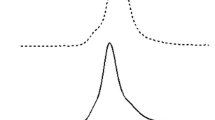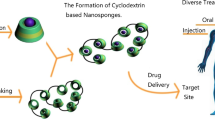Abstract
Purpose. The aim of this study was to prepare and characterize nanoparticulate systems constituted of poly(isobutylcyanoacrylate) and cyclodextrins and intended for increasing the loading of the particles with lipophilic substances. Progesterone was used as a model substance.
Methods. Nanoparticles were prepared by polymerization of isobutyl-cyanoacrylate in presence of cyclodextrins or progesterone/ hydroxy-propyl-β-cyclodextrin complex. Particle size, zeta potential, cyclodextrin and progesterone loading of the particles were determined.
Results. Nanoparticles could be easily prepared in presence of cyclodextrins. An increase in hydroxypropyl-β-cyclodextrin concentration resulted in small nanoparticles (less than 50 nm). It was found that large amounts of cyclodextrins remained associated to the particles, resulting in a 50 fold increase in progesterone loading compared to nanoparticles prepared in absence of cyclodextrins.
Conclusions. The poly(isobutylcyanoacrylate)—cyclodextrin nanoparticles were characterized by the presence of many lipophilic sites belonging to the cyclodextrins which were firmly anchored to the structure of the particles. Therefore, this new type of nanoparticles offers probably an opportunity for increasing the loading of nanoparticles with various lipophilic drugs.
Similar content being viewed by others
REFERENCES
J. Kreuter. Nanoparticles. In J. Kreuter (ed.), Colloidal Drug Delivery Systems, Marcel Decker, New York, 1994, pp. 219–342.
P. Couvreur, M. Roland, and P. Speiser. Biodegradable submicronic particles containing a biologically active substance and compositions containing then. U.S. Patent N o 4, 329–332, 1982.
M. Vikmon. Rapid and simple spectrophotometric method for determination of micro-amounts of cyclodextrins. Proceed. First International Symposium in Cyclodextrins, Budapest, 69–74, 1981.
S. J. Douglas, L. Illum, and S. Davis. Particle size distribution of poly(butyl 2-cyanoacrylate) nanoparticles. J. Colloid. Interf. Sci. 103:154–163 (1985).
C. Lourenço, M. Teixeira, S. Simões, and R. Gaspar. Steric stabilization of nanoparticles: size and surface properties. Int. J. Pharm. 138:1–12 (1996).
F. W. Lichtenthaller and S. Immel. The lipophilicity patterns of cyclodextrins and of non-glucose cyclooligosaccharides. Proceed. Eigth International Symposium of Cyclodextrins, 3–16, 1996.
M. Gallardo, G. Couarraze, B. Denizot, L. Treupel, P. Couvreur, and F. Puisieux. Study of the mecanisms of formation of nanoparticles and nanocapsules of polyisobutyl-2-cyanoacrylate. Int. J. Pharm. 100:55–64 (1993).
C. Verdun, P. Couvreur, H. Vranckx, V. Lenaerts, and M. Roland. Development of a nanoparticle controlled-release formulation for human use. J. Control. Rel. 3:205–210 (1986).
M. Fresta and G. Puglisi. Association of netilmicin sulphate to poly(alkylcyanoacrylate) nanoparticles: Factors influencing particle delivery behaviour. Drug Dev. Ind. Pharm. 20:2227–2243 (1994).
B. Seijo, E. Fattal L. Roblot-Treupel, and P. Couvreur. Design of nanoparticles of less than 50 nm diameter: preparation, characterization and drug loading. Int. J. Pharm. 62:1–7 (1990).
Ch. Tasset, N. Barette, S. Thysman, J. M. Ketelsgers, D. Lemoine, and V. Préat. Polyisobutylcyanoacrylate nanoparticles as sustained release system for calcitonin. J. Control. Rel. 33:23–30 (1995).
V. H. K. Li, R. Wood, J. Kreuter, T. Harmia, and J. Robinson. Ocular drug delivery of progesterone using nanoparticles. J. Microencapsul. 3:213–218 (1986).
S.-Z. Lin, M. Skiba D. Wouessidjewe, B. Agnus, and D. Duchêne. Inclusion complexes of progesterone and its analogue x with cyclodextrins. Proceed. 6th International Symposium on Cyclodextrins, Chicago, U.S.A., 460–465, 1992.
M.-C. Venier-Julienne and J. P. Benoit. Preparation, purification and morphology of polymeric nanoparticles as drug carriers. Pharmaceutica Acta Helvetiae, 7:121–128 (1996).
Author information
Authors and Affiliations
Rights and permissions
About this article
Cite this article
da Silveira, A.M., Ponchel, G., Puisieux, F. et al. Combined Poly(isobutylcyanoacrylate) and Cyclodextrins Nanoparticles for Enhancing the Encapsulation of Lipophilic Drugs. Pharm Res 15, 1051–1055 (1998). https://doi.org/10.1023/A:1011982211632
Issue Date:
DOI: https://doi.org/10.1023/A:1011982211632




